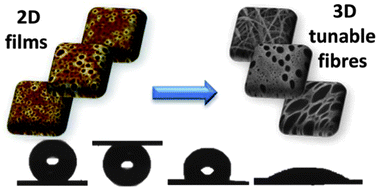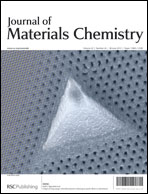Bicomponent fibre mats with adhesive ultra-hydrophobicity tailored with cellulose derivatives
Abstract
Morphologies featured in bicomponent 2D ultrathin films were reproduced on 3D non-woven microfibre structures. Fibre networks were constructed by electrospinning hydrophobised cellulose derivatives, trimethylsilyl cellulose (TMSC) and cellulose triacetate (CTA), dissolved in a common solvent. Diverse morphologies were obtained depending on the polymer blend ratio: electrospinning of TMSC produced non-continuous micron fibres with shallow dints, TMSC/CTA 5 : 1 flat micron fibres with regular pore arrays, TMSC/CTA 1 : 1 wrinkled micron fibres decorated with shallow dints and occasional larger pores, TMSC/CTA 1 : 5 flat micron fibres with ellipsoidal porous structures and finally, CTA that led to smooth micron and submicron fibres. The fibre mats were ultra-hydrophobic with characteristic water contact angles of ca. 150 degrees. In addition, they were characterised by high contact angle hysteresis, and water droplets adhered to the substrate even after tilting the system upside down. Through conversion of the respective components to cellulose, chemical and adsorption properties of the fibre networks could be tuned without significantly altering the large-scale network morphology.


 Please wait while we load your content...
Please wait while we load your content...